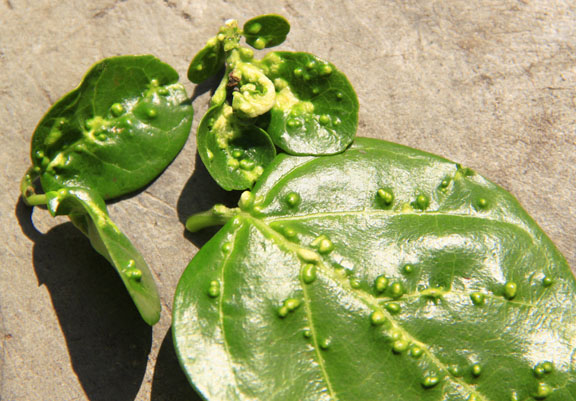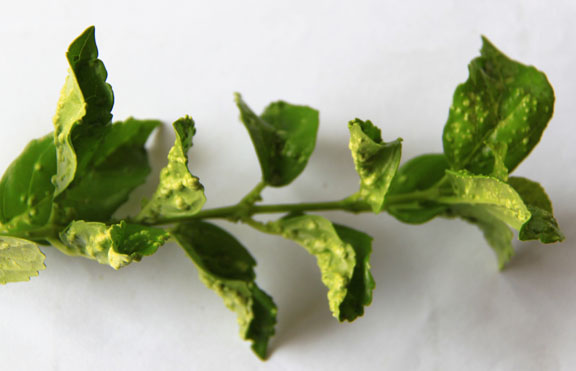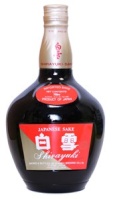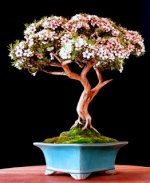HELP..HELP..!!!
+9
landerloos
JimLewis
Andre Beaurain
Rob Kempinski
pongsatorn.k
NeilDellinger
Pavel Slovák
Billy M. Rhodes
Robert Steven
13 posters
Page 1 of 2
Page 1 of 2 • 1, 2 
 HELP..HELP..!!!
HELP..HELP..!!!
Just very recently, lots of my Premna bonsai got this problem on their leaves..anyone can help what is it and how to handle it ???!!!
For info, we are now in raining season. I have tried to defoliate them, but the same problem occures again on the new leaves. Different pesticides had been tried without result...
The very common problem with Premna is the white scales on the trunk/branches and we can handle it. Such problem on the leaves never happened before. They only attack the leaves..




For info, we are now in raining season. I have tried to defoliate them, but the same problem occures again on the new leaves. Different pesticides had been tried without result...
The very common problem with Premna is the white scales on the trunk/branches and we can handle it. Such problem on the leaves never happened before. They only attack the leaves..



Last edited by Robert Steven on Tue Jan 17, 2012 8:55 am; edited 2 times in total (Reason for editing : mistype)

Robert Steven- Member
 Re: HELP..HELP..!!!
Re: HELP..HELP..!!!
It might be a bacteria or virus. In plants there is usually no treatment.

Billy M. Rhodes- Member
 Re: HELP..HELP..!!!
Re: HELP..HELP..!!!
Billy M. Rhodes wrote:It might be a bacteria or virus. In plants there is usually no treatment.
 So what to do Billy ?
So what to do Billy ? 
Robert Steven- Member
 Re: HELP..HELP..!!!
Re: HELP..HELP..!!!
First, get those plants away from everything else, hopefully under a screen or net to prevent insects from spreading the problem.
Second I think you wait for another opinion
If i am correct you must destroy with fire all infected plants as quickly as you see symptoms.
Second I think you wait for another opinion
If i am correct you must destroy with fire all infected plants as quickly as you see symptoms.

Billy M. Rhodes- Member
 Re: HELP..HELP..!!!
Re: HELP..HELP..!!!
Hi Robert
You can still try to isolate. Drought, no rain. Remove leaves and burn. Spraying with Sylit and Delan 700 WDG.
Best of luck.
Gretings Pavel
You can still try to isolate. Drought, no rain. Remove leaves and burn. Spraying with Sylit and Delan 700 WDG.
Best of luck.
Gretings Pavel

Pavel Slovák- Member
 Leaf Gall explanation
Leaf Gall explanation
Well don't burn you're damn trees before you figure it out...thats the most ridiculous thing I've ever heard. You may need to apply your insecticide(s) in a planned routine in order to catch the reproductive cycle of the invader at the right time. It may take awhile too. Spraying with soapy water or a stiff jet wont work, but is likely less costly than burning your trees up 
I hope this helps you!!
Heres a photo of a hackberry leaf gall. I've seen these all my life on trees in peoples yards. Its caused by the defensive reaction of the tree to a feedling aphid in the nymph stage. Other galls form and protect an insect in the larval stage.

It apparently does not harm the tree, and leaves continue to photosynthesize. The swelling is a defensive reaction by the tree to encapsulate a wound. At least thats what it is in many deciduous trees in the mid west. Heres the explanation to a host of gall like problems. Its provided by Kentucky College of Agriculture. http://www.ca.uky.edu/entomology/entfacts/ef403.asp
Galls are irregular plant growths which are stimulated by the reaction between plant hormones and powerful growth regulating chemicals produced by some insects or mites. Galls may occur on leaves, bark, flowers, buds, acorns, or roots. Their inner walls provide a high quality food source for the inhabitant as well as protection from insecticide sprays and some shelter from natural enemies. Important details of the life cycles of many gall makers are not known so specific timings of control measures are not available.
Gall makers must attack at a very specific time in order to be successful. Otherwise, they may not be able to stimulate the plant to produce the tissue which forms the gall. Generally, initiation of leaf galls occurs during the "bud break" stage or as new leaves begin to unfold.
Once the symptom or gall appears, the causative animal is protected within the structure. This means that remedial actions, other than pruning in some cases, are not effective. Preventive action is necessary to attempt to reduce the infestation the following season and these may be of limited value. Fortunately, most galls, especially those on leaves and leaf structures, do not harm the health of the tree.
Hackberry Leaf Gall
"This gall is caused by a small (1/10 inch long) aphid-like insect with sucking mouthparts called a jumping plant louse. The adults spend the winter under bark crevices and can invade houses in large numbers in the fall. Females lay eggs over a long period of time beginning when leaves begin to unfold from the buds in the spring. Feeding by the nymphs that hatch from these eggs causes abnormal plant growth that forms a pouch. The psyllids remain inside the galIs until they emerge as adults in late summer to early fall. There is one generation each year. Heavy infestations can result in premature leaf drop which over a series of years may affect tree health. An application of acephate (Orthene), carbaryl (Sevin) or chlorpyrifos (Dursban) may give some control."http://www.ca.uky.edu/entomology/entfacts/ef403.asp
I hope this helps you!!
Heres a photo of a hackberry leaf gall. I've seen these all my life on trees in peoples yards. Its caused by the defensive reaction of the tree to a feedling aphid in the nymph stage. Other galls form and protect an insect in the larval stage.

It apparently does not harm the tree, and leaves continue to photosynthesize. The swelling is a defensive reaction by the tree to encapsulate a wound. At least thats what it is in many deciduous trees in the mid west. Heres the explanation to a host of gall like problems. Its provided by Kentucky College of Agriculture. http://www.ca.uky.edu/entomology/entfacts/ef403.asp
Galls are irregular plant growths which are stimulated by the reaction between plant hormones and powerful growth regulating chemicals produced by some insects or mites. Galls may occur on leaves, bark, flowers, buds, acorns, or roots. Their inner walls provide a high quality food source for the inhabitant as well as protection from insecticide sprays and some shelter from natural enemies. Important details of the life cycles of many gall makers are not known so specific timings of control measures are not available.
Gall makers must attack at a very specific time in order to be successful. Otherwise, they may not be able to stimulate the plant to produce the tissue which forms the gall. Generally, initiation of leaf galls occurs during the "bud break" stage or as new leaves begin to unfold.
Once the symptom or gall appears, the causative animal is protected within the structure. This means that remedial actions, other than pruning in some cases, are not effective. Preventive action is necessary to attempt to reduce the infestation the following season and these may be of limited value. Fortunately, most galls, especially those on leaves and leaf structures, do not harm the health of the tree.
Hackberry Leaf Gall
"This gall is caused by a small (1/10 inch long) aphid-like insect with sucking mouthparts called a jumping plant louse. The adults spend the winter under bark crevices and can invade houses in large numbers in the fall. Females lay eggs over a long period of time beginning when leaves begin to unfold from the buds in the spring. Feeding by the nymphs that hatch from these eggs causes abnormal plant growth that forms a pouch. The psyllids remain inside the galIs until they emerge as adults in late summer to early fall. There is one generation each year. Heavy infestations can result in premature leaf drop which over a series of years may affect tree health. An application of acephate (Orthene), carbaryl (Sevin) or chlorpyrifos (Dursban) may give some control."http://www.ca.uky.edu/entomology/entfacts/ef403.asp
NeilDellinger- Member
 Re: HELP..HELP..!!!
Re: HELP..HELP..!!!
By the way.....I've had these on a cork bark elm a few times. I pluck the leaves and spray with a systemic (acephate). As new leaves emerge I use neem oil a few times. It usually happens in the spring as insects become active. I've never seen the bug but the thing only lasted a short time and never returned until the next season.
NeilDellinger- Member
 Might be Mites!
Might be Mites!
I don't know the exact insect or other causative agent but I'd think about defoliating the trees and taking the leaf to a local agricultural agency or university for possible identification help. If they can identify it I'd then spray with the appropriate chemical and start using a systemic for defensive purposes.
If there is no local agricultural agency you can try Google. Looking at Google I tried “leaf galls on Premna” and came up with a coupe of possible theories. All appear to be caused by a form of mite. I’d look into miticide (I used Keltane) and a systemic.
In this article it mentions a mite called Aceria Sp E. Galls on top and in bad cases on the bottom of the Premna leaf. This could be it.
http://books.google.com/books?id=188UAAAAIAAJ&pg=PA139&lpg=PA139&dq=leaf+gall+on+premna'&source=bl&ots=XHUiFIZDWd&sig=xQk-zqRybMIYl31fMaawDLeQib4&hl=en#v=onepage&q=leaf%20gall%20on%20premna'&f=false
The mite in this article is only on the top of the leaf so probably is not it.
http://books.google.com/books?id=RlE1_jsBtbAC&pg=PA574&lpg=PA574&dq=leaf+gall+on+premna'&source=bl&ots=AkQfSiwzU6&sig=pm7CffGnHxi5nJLZfCnwMXIdLHg&hl=en#v=onepage&q=leaf%20gall%20on%20premna'&f=false
One article said galls are common on Premna leaves. I haven't seen any galls on my Premna but then Florida is not their native environment. Right now my leaves are suffering due to cold weather.
Good luck.
If there is no local agricultural agency you can try Google. Looking at Google I tried “leaf galls on Premna” and came up with a coupe of possible theories. All appear to be caused by a form of mite. I’d look into miticide (I used Keltane) and a systemic.
In this article it mentions a mite called Aceria Sp E. Galls on top and in bad cases on the bottom of the Premna leaf. This could be it.
http://books.google.com/books?id=188UAAAAIAAJ&pg=PA139&lpg=PA139&dq=leaf+gall+on+premna'&source=bl&ots=XHUiFIZDWd&sig=xQk-zqRybMIYl31fMaawDLeQib4&hl=en#v=onepage&q=leaf%20gall%20on%20premna'&f=false
The mite in this article is only on the top of the leaf so probably is not it.
http://books.google.com/books?id=RlE1_jsBtbAC&pg=PA574&lpg=PA574&dq=leaf+gall+on+premna'&source=bl&ots=AkQfSiwzU6&sig=pm7CffGnHxi5nJLZfCnwMXIdLHg&hl=en#v=onepage&q=leaf%20gall%20on%20premna'&f=false
One article said galls are common on Premna leaves. I haven't seen any galls on my Premna but then Florida is not their native environment. Right now my leaves are suffering due to cold weather.
Good luck.

Rob Kempinski- Member
 Re: HELP..HELP..!!!
Re: HELP..HELP..!!!
Thanks Neil and Rob for the very valuable info. I will try anything rather than burning.. 
So far, it doesn't harm the tree, but only the leaves..

So far, it doesn't harm the tree, but only the leaves..

Robert Steven- Member
 Re: HELP..HELP..!!!
Re: HELP..HELP..!!!
Hallo people, so gald to find this spot,but my intro later..
The insect that sucks on the new growth is called Scylla, Citrus trees often get it, it is harmless but can be treated with a systamatic insecticide.
If however the 'galls' turn pink or red, then it is Leave curl,Taprina deformans, usually if wet humid weather prevails the fungus blooms.
a yearly spray of lime sulphur will take care of all the nasties, but you can only spray when trees are dormant and without leaves. Or you can spray now with a copper-oxychloride.
The insect that sucks on the new growth is called Scylla, Citrus trees often get it, it is harmless but can be treated with a systamatic insecticide.
If however the 'galls' turn pink or red, then it is Leave curl,Taprina deformans, usually if wet humid weather prevails the fungus blooms.
a yearly spray of lime sulphur will take care of all the nasties, but you can only spray when trees are dormant and without leaves. Or you can spray now with a copper-oxychloride.

Andre Beaurain- Member
 Re: HELP..HELP..!!!
Re: HELP..HELP..!!!
Thanks Andre...
I have just asked my people to take off all the leaves and burn the leaves (not the tree.. )..then try to find out what to spray etc...
)..then try to find out what to spray etc...
I have just asked my people to take off all the leaves and burn the leaves (not the tree..
 )..then try to find out what to spray etc...
)..then try to find out what to spray etc...
Robert Steven- Member
 Re: HELP..HELP..!!!
Re: HELP..HELP..!!!
Galls are almost always species specific. Citrus gall, or other galls will not affect your tree. There are MANY causes. They are caused by any number of things -- virus, bacteria, or insect boring into the leaf, laying eggs; insects sucking juices and tree trying to wall off injury, etc.
Until you identify the cause of the infestation, there is NO point spraying with anything. An insecticide will do nothing for a bacteria or virus; spraying the surface of the leaf will do nothing for an insect that has bored into the leaf. Ditto systemic if it's not a sucking insect, or something leaving a larva inside the leaf. Perhaps you can dissect one of the galls and see if there is a larvae inside.
So take the leaves to an expert somewhere and get the culprit Identified.
Failing that, Isolate the trees, remove all leaves and destroy them.
The only consolation I can offer is that galls seldom kill the tree.
Until you identify the cause of the infestation, there is NO point spraying with anything. An insecticide will do nothing for a bacteria or virus; spraying the surface of the leaf will do nothing for an insect that has bored into the leaf. Ditto systemic if it's not a sucking insect, or something leaving a larva inside the leaf. Perhaps you can dissect one of the galls and see if there is a larvae inside.
So take the leaves to an expert somewhere and get the culprit Identified.
Failing that, Isolate the trees, remove all leaves and destroy them.
The only consolation I can offer is that galls seldom kill the tree.

JimLewis- Member
 Re: HELP..HELP..!!!
Re: HELP..HELP..!!!
JimLewis wrote:Galls are almost always species specific. Citrus gall, or other galls will not affect your tree. There are MANY causes. They are caused by any number of things -- virus, bacteria, or insect boring into the leaf, laying eggs; insects sucking juices and tree trying to wall off injury, etc.
Until you identify the cause of the infestation, there is NO point spraying with anything. An insecticide will do nothing for a bacteria or virus; spraying the surface of the leaf will do nothing for an insect that has bored into the leaf. Ditto systemic if it's not a sucking insect, or something leaving a larva inside the leaf. Perhaps you can dissect one of the galls and see if there is a larvae inside.
So take the leaves to an expert somewhere and get the culprit Identified.
Failing that, Isolate the trees, remove all leaves and destroy them.
The only consolation I can offer is that galls seldom kill the tree.
I agree with Jim on this one
Peter

landerloos- Member
 Re: HELP..HELP..!!!
Re: HELP..HELP..!!!
Hi robert,
As you know it is a gall, these are usually a plants' defences against attack from a bug, and are often followed by a seciondary infection from bacteria or virus (many of the virus's are carried by the bug i believe).
I'm checking through a few databases and have found one species of mite that is attacking premna - here is the info:
Genotype as follows :
Baileyna marianae Keifer, new species
Plate 237
Female 160-210p long, 30-40p thick, wormlike, curved, brown color. Rostrum 18p
long curved down. Shield 25p long 35p wide, smootl~; dorsal tubercles 20p apart,
seta; 20p long. Forelegs 27p long iibia 6p long, seta present; tarsus ip long, claw
6.5p long, featherclaw 4-rayed. ~ i h d l e g s2 4p long, tibia 6p long, tarsus 6p long, claw
7.5p long. Anterior coxae contiguous. Abdomen with about 40 tergites, 50 or more
sternites. Lateral seta 15p long, on about sternite 8. first ventral seta 31p long 011
about sternite 18 ; second ventral 7~ long, on sternite'31; third ventral seta 16p lIbng,
on sternite 6 from rear. Accessory seta present. Female genitalia 19p wide, 16p long,
coverflap with 7 or 8 longitudinal furrows; seta Sp long.
Male not seen.
Type locality: Tinian Islancl, JIarianas Group. Collected: November,
1944, by Dr. S. F. Bailey. Host: Prenzna sp. (Verbeniaceae), a
shade tree. Relation to host: The mites form upper surface pouch
galls oil the leaves. These galls range up to 4 inch long. Type material:
As well as dry leaf galls with mites there is a type slide and five paratype
slides. In addition I have specimens of this mite from Guam under
U. S. Agricultural Research Service numbers 53-11653 and 53-12784.
These collections were by 0. N. Liming at Marbo Caves, September 5
and 21, 1953. The description of this new genus and species immediately
introduces the problem of the relationship of this Marianas mite to
Phyllocoptes angzcstz~s prenxqzae Nal., described from Batavia, Java,
1923. The reference is Treubia, 3 :429. Nalepa7s species forms galls on
the leaves of Premna integrifolia L. It also has large ventral rnicrotubercles.
Nalepa states that his subspecies has the tergites "flattened or
moderately sunken," which does not at all describe the system of furrows
shown by the Marianas mite. The dorsal furrows, combined with
the coarse ventral microtuberculation should distinguish this genus from
all other Eriophyid genera."
as you can see they are very small, you wont be cutting the gall open and spotting them crawling around ! i'll keep looking for more. Once we have a few likely culprits we can sort out a treatment.
here is a book that shows up on a google search for premna leaf gall with chapters that point to a mite as well
mite book
cheers Marcus
As you know it is a gall, these are usually a plants' defences against attack from a bug, and are often followed by a seciondary infection from bacteria or virus (many of the virus's are carried by the bug i believe).
I'm checking through a few databases and have found one species of mite that is attacking premna - here is the info:
Genotype as follows :
Baileyna marianae Keifer, new species
Plate 237
Female 160-210p long, 30-40p thick, wormlike, curved, brown color. Rostrum 18p
long curved down. Shield 25p long 35p wide, smootl~; dorsal tubercles 20p apart,
seta; 20p long. Forelegs 27p long iibia 6p long, seta present; tarsus ip long, claw
6.5p long, featherclaw 4-rayed. ~ i h d l e g s2 4p long, tibia 6p long, tarsus 6p long, claw
7.5p long. Anterior coxae contiguous. Abdomen with about 40 tergites, 50 or more
sternites. Lateral seta 15p long, on about sternite 8. first ventral seta 31p long 011
about sternite 18 ; second ventral 7~ long, on sternite'31; third ventral seta 16p lIbng,
on sternite 6 from rear. Accessory seta present. Female genitalia 19p wide, 16p long,
coverflap with 7 or 8 longitudinal furrows; seta Sp long.
Male not seen.
Type locality: Tinian Islancl, JIarianas Group. Collected: November,
1944, by Dr. S. F. Bailey. Host: Prenzna sp. (Verbeniaceae), a
shade tree. Relation to host: The mites form upper surface pouch
galls oil the leaves. These galls range up to 4 inch long. Type material:
As well as dry leaf galls with mites there is a type slide and five paratype
slides. In addition I have specimens of this mite from Guam under
U. S. Agricultural Research Service numbers 53-11653 and 53-12784.
These collections were by 0. N. Liming at Marbo Caves, September 5
and 21, 1953. The description of this new genus and species immediately
introduces the problem of the relationship of this Marianas mite to
Phyllocoptes angzcstz~s prenxqzae Nal., described from Batavia, Java,
1923. The reference is Treubia, 3 :429. Nalepa7s species forms galls on
the leaves of Premna integrifolia L. It also has large ventral rnicrotubercles.
Nalepa states that his subspecies has the tergites "flattened or
moderately sunken," which does not at all describe the system of furrows
shown by the Marianas mite. The dorsal furrows, combined with
the coarse ventral microtuberculation should distinguish this genus from
all other Eriophyid genera."
as you can see they are very small, you wont be cutting the gall open and spotting them crawling around ! i'll keep looking for more. Once we have a few likely culprits we can sort out a treatment.
here is a book that shows up on a google search for premna leaf gall with chapters that point to a mite as well
mite book
cheers Marcus

marcus watts- Member
 Re: HELP..HELP..!!!
Re: HELP..HELP..!!!
marcus watts wrote:Hi robert,
snip
Female 160-210p long, 30-40p thick, wormlike, curved, brown color. Rostrum 18p
long curved down. Shield 25p long 35p wide, smootl~; dorsal tubercles 20p apart,
seta; 20p long. Forelegs 27p long iibia 6p long, seta present; tarsus ip long, claw
6.5p long, featherclaw 4-rayed. ~ i h d l e g s2 4p long, tibia 6p long, tarsus 6p long, claw
...
as you can see they are very small, you wont be cutting the gall open and spotting them crawling around ! i'll keep looking for more. Once we have a few likely culprits we can sort out a treatment.
Marcus
Marcus - out of curiosity, what unit of measurement is a "p"?

Rob Kempinski- Member
 Re: HELP..HELP..!!!
Re: HELP..HELP..!!!
hello robert:
we have similar looking galls showing up on chinese banyan and hibiscus . we treat with systemic (merit is good) and it knocks it back.
best wishes, sam
we have similar looking galls showing up on chinese banyan and hibiscus . we treat with systemic (merit is good) and it knocks it back.
best wishes, sam
kauaibonsai- Member
 Re: HELP..HELP..!!!
Re: HELP..HELP..!!!
Let me add to my earlier message that if the species grows naturally or as a garden plant in your neighborhood, you probably will have great difficulty eliminating, or even controlling it as it probably is at large in the local population. You will therefore seen every year, depending on its life cycle.
I know, very depressing.
I know, very depressing.

JimLewis- Member
 Re: HELP..HELP..!!!
Re: HELP..HELP..!!!
Rob Kempinski wrote:
Marcus - out of curiosity, what unit of measurement is a "p"?
hi rob, i think this is a pico, a trillionth ! of a meter (a millionth of a million) 0r 0.000000000001m. (or very very small
As Jim quite rightly points out it would be a wild population, and quite often a bonsai collection is a concentration of tasty trees close together and with denser foliage than normal, making a good environment for pests to flourish. Natural populations go through cycles too, so this particular mite could be at the peak of a population explosion hence showing more damage to Roberts bonsai than before.
Reading a post the other day i think it spoke of using many liters of lime sulphar in a day - it turned out the entire bonsai yard / area had been sprayed with 30:1 ls dilution as pest control. Even though we are often surrounded by pests it is still better and possible to reduce some of them from epidemic levels near our trees. I think the japanese growers and nurseries are miles ahead of us when it comes to widespread pest control - reading what several of the apprentices have written a nursery wide spray at various times of the year is standard practice. - last week i sprayed all my trees as i found some tiny catapilla embryos in curled up azaelia leaves. I think a routine spray of the area as part of a spring clean could become a beneficial practice.
cheers Marcus

marcus watts- Member
 Re: HELP..HELP..!!!
Re: HELP..HELP..!!!
Thank you..everyone..for your valuable info and advices. I hope I can handle it...

Robert Steven- Member
 Re: HELP..HELP..!!!
Re: HELP..HELP..!!!
Robert, u have lots of good informations and advises from many people.
I will just add my practical experiences in handling the leaf-gall I have on my lilly-pilly bonsai. I found that it was cause by tiny insects (less than .3mm but visible to the naked eye) which lay eggs on the underside of the leave. The leave reacted by buldging upwards where the eggs are. I have not got them identified as they only cause some ugliness on the leave and my preventive measures seem to keep them under control. I found that like most insects, it is not possible to eradicate them completely. The moment I neglected on my preventive measures, they come back without fail. My preventive measures consisted of two forms of insecticides. First I removed all the affected leave and safely destroyed them. Then I sprayed a residual insecticide "coopex" which is permethrin. It is claimed to last for up to 3 months if it is not wash away by rain or watering. I also sprinkled a systematic insecticide on top of the soil. The bonsai will absorb the insecticide into its' system which will discourage the insect from attacking it. So long as I am diligent in executing these preventive measures, the problem is under control. The moment I neglected, they are back. It is an ongoing efforts. Remember to wear protective gears when spraying insecticide.
All the best.
CJ
I will just add my practical experiences in handling the leaf-gall I have on my lilly-pilly bonsai. I found that it was cause by tiny insects (less than .3mm but visible to the naked eye) which lay eggs on the underside of the leave. The leave reacted by buldging upwards where the eggs are. I have not got them identified as they only cause some ugliness on the leave and my preventive measures seem to keep them under control. I found that like most insects, it is not possible to eradicate them completely. The moment I neglected on my preventive measures, they come back without fail. My preventive measures consisted of two forms of insecticides. First I removed all the affected leave and safely destroyed them. Then I sprayed a residual insecticide "coopex" which is permethrin. It is claimed to last for up to 3 months if it is not wash away by rain or watering. I also sprinkled a systematic insecticide on top of the soil. The bonsai will absorb the insecticide into its' system which will discourage the insect from attacking it. So long as I am diligent in executing these preventive measures, the problem is under control. The moment I neglected, they are back. It is an ongoing efforts. Remember to wear protective gears when spraying insecticide.
All the best.
CJ
Last edited by newzealandteatree on Wed Jan 18, 2012 1:49 pm; edited 1 time in total (Reason for editing : Add sentence.)

newzealandteatree- Member
 Re: HELP..HELP..!!!
Re: HELP..HELP..!!!
Hi CJ. Thanks so much for your additional info. We are trying now...and cross my fingers....

Robert Steven- Member
 Re: HELP..HELP..!!!
Re: HELP..HELP..!!!
Robert,
We had the same problem with Bucida. I have a bactericide that takes care of the problem. Should you want, I can take you a bottle in April.
Kind regards,
Jose Luis
We had the same problem with Bucida. I have a bactericide that takes care of the problem. Should you want, I can take you a bottle in April.
Kind regards,
Jose Luis

jrodriguez- Member
Page 1 of 2 • 1, 2 
Page 1 of 2
Permissions in this forum:
You cannot reply to topics in this forum






